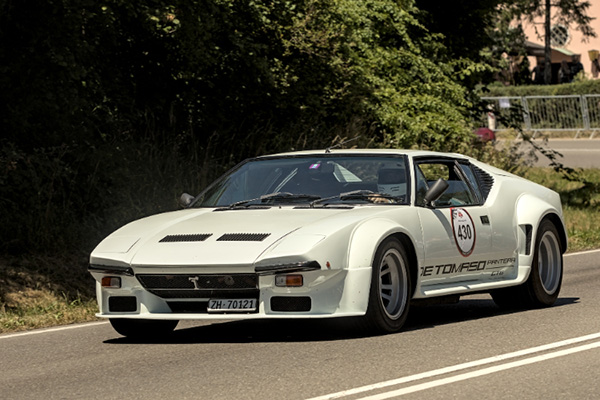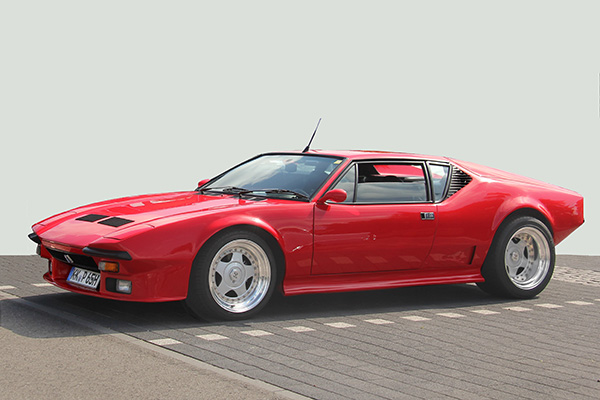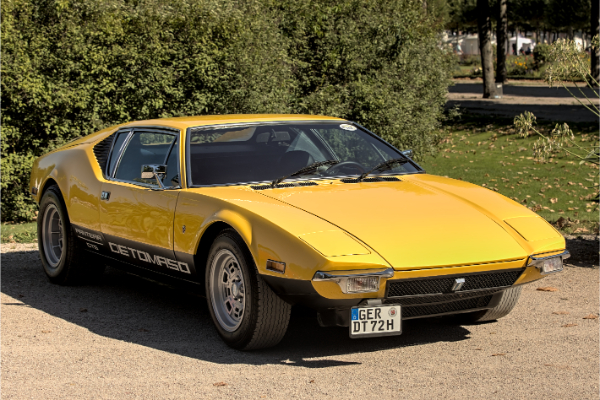De Tomaso Pantera – 1970 (55 years)
The De Tomaso Pantera – even the name just exudes cool and, as monikers go, there’s little to rival it, not only in the automotive world, but the world itself. Only Djamolidine Abdoujaparov – the legendary Tour de France sprinter – comes close in terms of pure romanticism when you hear it spoken aloud.
That name has just got a rhythm to it: you can imagine the customer sales rep on the other end of the line when taking out classic car insurance: ‘You’ve got a De tomato what?’ You’ll probably have to spell it out.
So, the name is a wonder on its own, only to be eclipsed by Uzbeki-born cyclists. And the two have something in common. Like Abdoujaparov, the Pantera was fast – in a mercurial kind of way. It’s not hang-on-to-the-seat-buffer-and-pray fast, but more a ‘blimey, where’d that come from’ fast. A classic, dignified alacrity if you like. For the record, it was capable of accelerating from 0-62mph in 5.5 seconds and, for a car built in the 1970s, that’s no slouch.
The other thing worth noting about the De Tomasa Pantera is that it looks achingly lovely. You might point to the Ferrari 250 GT, the Lamborghini Miura, the Mercedes-Benz 280SL Pagoda as candidates for the ‘most beautiful car ever made’ and all that unnecessary click-bait nonsense, but the Pantera – if you want automotive fisticuffs at dawn – is in the running for that particular accolade.
So, what else?
Well, here’s a few facts to wet your whistle in advance of automotive pub chat. It’s mid-engined, production started in 1971 and ended in 1992, it is arguably the Italian sports car maker’s most famous car and more than 7,000 were manufactured over its lifetime.
The name comes from the Italian word for Panther. The company's founder, Alejandro de Tomaso, probably chose the name to evoke predatory associations with the large cat. Whatever, it’s a great name, particularly with ‘De Tomaso’ in front of it.
You might then be asking, who designed it – a perfectly reasonable question. It was not designed by Pininfarina or Bertone, but by the Italian design firm Carrozzeria Ghia’s American-born designer Tom Tjaarda – a relatively unknown automotive pensman with way too many vowels in his name.

The car debuted in Modena in March 1970 and was presented at the 1970 New York Motor Show a few weeks later. Approximately a year after that the first production cars were sold and build numbers increased to three per day.
As is the norm with Italian cars, there was plenty to criticise. The pedals were offset – a major irritant for drivers who consider themselves enthusiasts – and headroom was in short supply. Anyone over 6ft would find the Pantera challenging: Jeremy Clarkson need not apply.
There was some fun stuff though. Standard features included electric windows, air conditioning (although really rather rubbish in terms of output), and, fantastically, doors that buzzed when opened. Not so much fun was the location of the cigarette lighter. Dropping an elbow on to central console was risky: before you knew it the car would be smelling of burned metal.

Sensibly, the Pantera was powered by an appropriate engine – a 5.8-litre, Ford Cleveland V8 that produced a somewhat hearty 330hp. The high torque reduced the need for excessive gear changing at low speeds and this made the car much less demanding to drive in urban conditions. You might even have called it ‘practical’.
As is the norm, the ante needed to be upped – mostly to generate more interest. Sports car makers can’t resist because if you own a ‘standard’ Pantera, where do you go from there? There has to be another level in the performance car game, otherwise you are just standing still – and that’s never a good look in this sector.
Predictably then, in the spring of 1972, De Tomaso introduced the more sporting GTS model for the European market. The GTS was developed for Group 3 racing and received a more powerful engine with 350hp. It also featured considerably wider wheels, a more aggressive steering rack set-up, ventilated disc brakes, adjusted spring rates and gear ratios, and conspicuous matte black body elements.

The car then, you might argue, was a stonking success. It went fast, it looked the part, it had a cool name and a V8 unit – all the stuff you want from a supercar. And it attracted attention, particularly in the American market – even Elvis bought one.
Elvis’s relationship with the Pantera started off badly, however. He paid $2,500 for it at a Cadillac dealership, but when he couldn’t get the thing to start, he pulled out a small-calibre revolver and fired two shots towards dashboard. Perfectly reasonable behaviour.
The damage was limited, however: the windscreen was shattered and a front tyre was punctured by one of the duo of bullets that found its way through the bulkhead, somehow. He sold the car in 1976 where it would fall into the hands of publishing mogul Robert Petersen in the late 1990s, before eventually being interred indefinitely at the Petersen Automotive Museum.
The DeTomaso Pantera has now reached the ripe old age of 55, if you take it from its debut in Modena. It’s aged gracefully and is still revered by enthusiasts. It’s not well-known to the non-enthusiast, who will understand what a Ferrari or a Lamborghini is, but that is part of its charm. It’s got game though: the name is cool, it’s got a great engine, it’s suitably fast and Elvis owned one. What’s not to like?

COMMENT